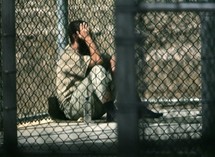
Prison regulations have long required that hunger strikers at the controversial detention facility for terror suspects be force-fed if their health is endangered by their decision to refuse food or their weight drops.
A prisoner at the camp is defined as on hunger strike if they refuse nine consecutive meals, Fagan said.
"We currently have less than 10 hungers strikers and less than 10 enteral feeders," he told AFP, adding that not all those on hunger strike were being fed via a tube inserted into the prisoners' stomachs.
"The number for both changes every day," he said.
Force-feeding involves strapping a detainee twice a day into a restraint chair and inserting a thin rubber tube via a prisoner's throat into his stomach. Prisoners are fed Ensure, a flavored liquid nutrient mix.
The process is reserved for detainees who decline to eat solid food, Fagan said, adding that the choice is provided to all hunger striking prisoners.
"It is a detainee's right to hunger strike and we do not try to break it. Some hunger strikers do consume solid food and some drink the Ensure supplement but they like to be considered hunger strikers just to make a statement," he said.
Fagan said the number of detainees on hunger strike at the facility, where some 176 terror suspects remain, had fallen significantly, though he provided no concrete figures.
"We attribute the decrease in hunger strikers to the increase in communal living privileges that nearly 90 percent of the detainee population is living in now," he said.
President Barack Obama had pledged to close Guantanamo within a year of taking office, but was forced to let the deadline lapse amid difficulties repatriating and prosecuting detainees and opposition from Congress to bringing prisoners to the United States for trial or continued imprisonment.
-----------------------------------------------------------------------
A prisoner at the camp is defined as on hunger strike if they refuse nine consecutive meals, Fagan said.
"We currently have less than 10 hungers strikers and less than 10 enteral feeders," he told AFP, adding that not all those on hunger strike were being fed via a tube inserted into the prisoners' stomachs.
"The number for both changes every day," he said.
Force-feeding involves strapping a detainee twice a day into a restraint chair and inserting a thin rubber tube via a prisoner's throat into his stomach. Prisoners are fed Ensure, a flavored liquid nutrient mix.
The process is reserved for detainees who decline to eat solid food, Fagan said, adding that the choice is provided to all hunger striking prisoners.
"It is a detainee's right to hunger strike and we do not try to break it. Some hunger strikers do consume solid food and some drink the Ensure supplement but they like to be considered hunger strikers just to make a statement," he said.
Fagan said the number of detainees on hunger strike at the facility, where some 176 terror suspects remain, had fallen significantly, though he provided no concrete figures.
"We attribute the decrease in hunger strikers to the increase in communal living privileges that nearly 90 percent of the detainee population is living in now," he said.
President Barack Obama had pledged to close Guantanamo within a year of taking office, but was forced to let the deadline lapse amid difficulties repatriating and prosecuting detainees and opposition from Congress to bringing prisoners to the United States for trial or continued imprisonment.
-----------------------------------------------------------------------









 Home
Home Politics
Politics









